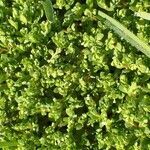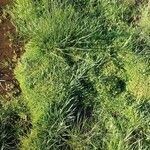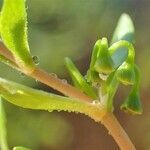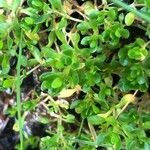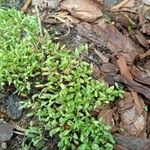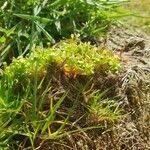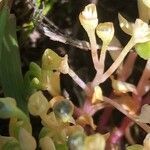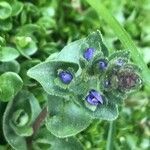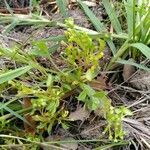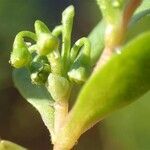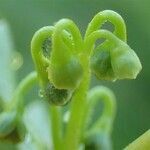Lax, branching annual or seldom perennial, 1–3 dm, often rooting from the nodes; lvs oblanceolate or spatulate or obovate, 0.5–1.3 cm; pedicels solitary or paired in the axils and terminal, to 1 cm, or the fls in 2–4-fld cymules from the upper axils; pet 5, white, ca 1.5 mm, often unequal, united at the base into a short tube split on one side; stamens 3. Springs, brooks, or wet soil, often ± aquatic; irregularly cosmopolitan, with 4 vars. differing in the ornamentation of the seed-coat. June–Sept. Our plants, with the seed-coat shiny and nearly smooth, belong to the chiefly boreal var. fontana, occurring s. to N.S. and Me. (M. lamprosperma; M. rivularis, a ± perennial phase)
Aquatic herb, in patches up to c. 6 cm high. Leaves opposite, elliptic, up to 4 by 2 mm, not caducous but decaying. Flowers solitary or 2-3 together with a membranaceous bract, inserted in the axil of a leaf. Sepals suborbicular, c. 1.2 mm ø, acute to mucronate. Petals 5, obovate to spathulate, 2 larger, up to 1.6 by 1 mm, 3 smaller, up to 1.6 by 0.6 mm, the latter each with an epipetalous stamen. Filaments up to c. 1 mm; anthers c. 0.34 by 0.17 mm. Style arms 3, sub-sessile, c. 0.1 mm long. Fruit globular, c. 1.2 mm ø; the 3 valves twisted after dehiscence. Seeds 2-3, c. 1.2 mm Ø; testa cells radially elongated.
Annual or perennial. Stems slender, weak, decumbent, not rooting at nodes, (1)-5-50 cm long. Lvs opposite, spreading, linear-oblanceolate to obovate-spathulate, acute, (5)-10-20-(25) × (1)-2-5 mm, cuneately narrowed to slightly sheathing base. Fls axillary, solitary or in 2-3-(5)-flowered cymes. Bracts obovate-subulate, scarious, 1-2 mm long. Sepals suborbicular, 1.5-2 mm long. Petals greenish white, obovate, 2-3 mm long. Anthers introrse, white. Capsule globose, slightly > calyx. Seeds 3, ovoid, black with white aril, either smooth and shiny or tuberculate and dull, 0.9-1.4 mm long.
Slender glab. branching herb up to 15 cm. or more tall, forming dense or loose tufts. Lvs opp., 0·5-2.5 cm. long, linear-lanceolate to spathulate to narrow-ovate, acute or subacute. Fls axillary or terminal, solitary or in 2-3-(5)-fld cymes, ± 2-3 mm. diam.; petals slightly > sepals, greenish white. Capsules hardly = sepals; seeds 3, c. 1 mm. diam., black.
A small leafy annual herb. The stems often lie along the ground. They can be 30 cm long. It forms roots at the nodes. The leaves are small and fleshy. They are opposite and without stalks. They are broadly sword shaped and can be 2 cm long by 1 cm wide. There are 1-8 flowers in agroup. The seeds are about 1 mm across.
